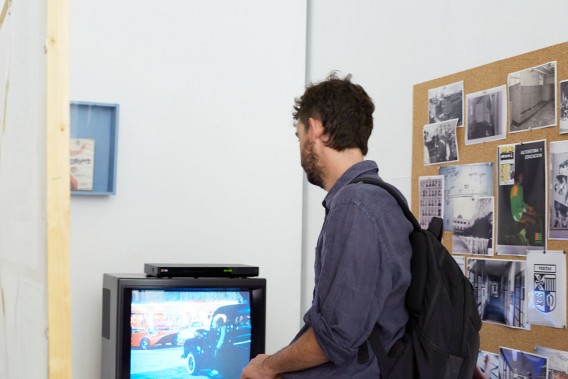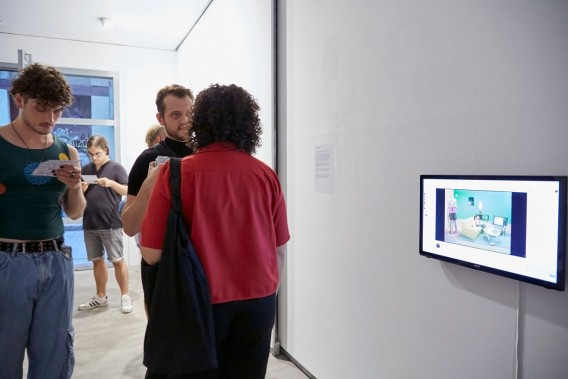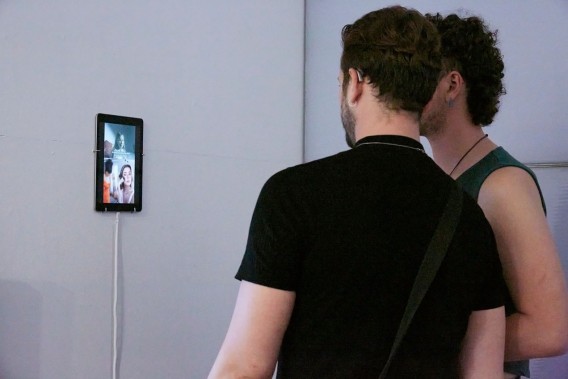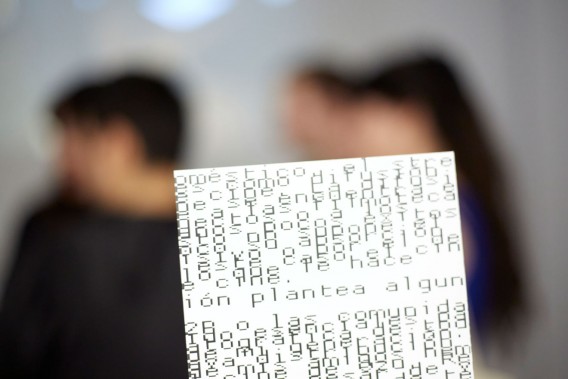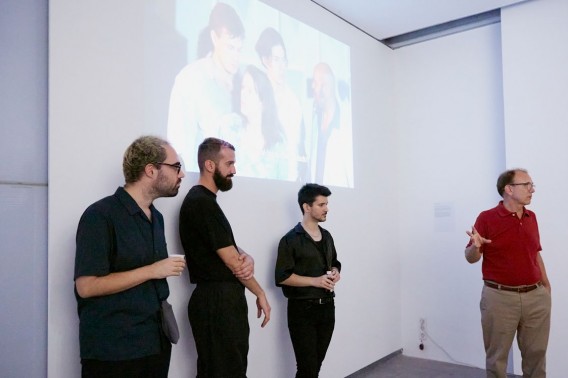˂VHS/VOD/TikTok/Cine˃ Cinema and its formats, expanded cinema exhibition curated by Aitor de Maenza and Guillem Cervera, includes the following audiovisuals:

“The understanding of domestic and cyclical time-space in the cinema of Ozu Yasujirō takes material form in Hara Setsuko, ‘The Eternal Virgin’, woman-actress-character-myth constantly alone in the frame, accomplice in an attack against classical understanding of the raccord.”
Jorge Suarez
Taking advantage of the fact that it seems that the actress Hara Setsuko was always playing the same character in Ozu Yasujiro’s films ―“The Eternal Virgin” which gives the title to this work―, the author of the audiovisual, Jorge Suárez, carries out a exercise impossible of raccord, that does not respect any of its rules. While the character seems to be playing the same sequence that never ends, the truth is that around him the house, the wardrobe, the hairstyle are changing, everything that is not supposed to change to make it plausible that we are facing the definitive film of that Eternal Virgin that film critics praised.
The one described is not the only alteration in this audiovisual by Jorge Suárez, of what is understood as cinematic realism. If on a first viewing of this work it seems that we are faced with an exercise in mythomania, in this case focused on the figure of Hara Setsuko, who has gone down in history as the muse of Ozu Yasujiro, what we discover, going a little further there, it is a work of cinematographic metalinguism that would seek to give us a first explanation of how the construction of a myth occurs, in a very intense interrelation with the domestic environment. A myth that would be something like the representation of the ideal woman model, which would later have to be deconstructed. A kind of “Semiotics of the Kitchen” (1975), by Martha Rosler, but in reverse. However, if we continue analyzing the film material that Sergio Suárez puts before us, what we finally discover hidden inside this work, seen from the current perspective (six years have passed since it was made), is that it shows us how false was the image of the woman that that actress represented, who had been stripped of her own image, ultimately of herself. Putting us on the track of the falsity of the representation that Ozu put before us, the surprising biography of Hara Setsuko written by Ishii Taeko: Hara Setsuko no shinjitsu (The truth about Hara Setsuko), published in 2016, where ―according to the synopses and the references that have been made public (because the book has not been published in Spanish)― it turns out that Hara Setsuko would have retired from acting when Ozu Yasujirō died in 1963, not because with the disappearance of the famous director the life of the Eternal Virgin that she had been representing with great acceptance by the public and critics would have ended ―for the simple reason that it would no longer be possible to continue playing that role―, but because, with the death of Ozu, she was freed from having to continue representing this character, with whom she would not have felt identified, in which she would have fallen due to pressure from Ozu, her supposed platonic love (another falsehood), because in reality she did not want to be that submissive and complacent woman, but rather, who she had inside Hara Setsuko was a woman with her own will who had not been allowed to express herself.
However, paradoxically, despite everything said, the fact is that the myth of the Eternal Virgin that Hara Setsuko represented so magnificently, as the representation of the new Japanese woman emerging from the lesson of World War II, which, like Japan, it had to be submissive and surrender to the dictates of the model from the West. This representation had an enormously widespread impact on Japanese popular culture in the sixties and seventies of the last century, so much so that it was even mimicked on the drag scene, particularly in the epicenter of the Tokyo underground that was developing in the Shinjuku neighborhood, and more specifically in Kabukicho, the prostitution area, with an abundance of transvestites, transsexuals, drags and other genders outside the binary world. In that environment, the Eternal Virgin shone with great strength as the image of a woman to imitate. She can be seen in the photographs of the best portraitist in that world: Katsumi Watanabe.
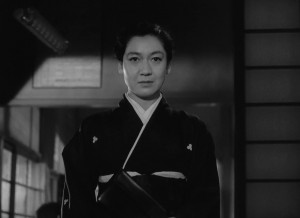
Hara Setsuko, in her eternal role as the Eternal Virgin, in “Twilight in Tokyo” (1957) by Ozu Yasujirō.
And below, the reinterpretation of the character, as a model of femininity (submissive and complacent), in the underground environment of Shinjuku (Tokyo), portrayed by Katsumi Watanabe.

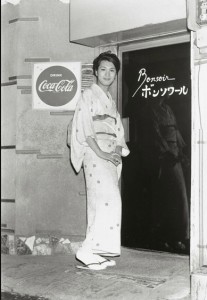
On the other hand, the exhibition of this work by Jorge Suárez occurs on a computer monitor manufactured in the temporary transition between the tube screens typical of the times of the MS-DOS operating system, with a 4:3 and 28″ ratio, and the flat LCD screens that would come later ―with a 16:9 and 32 ratio, which became widespread when Microsoft began to name the successive versions of Windows with numerals, abandoning the edition dates―. A truly unique device, which allows us to view “The Eternal Virgin” in the original 4:3 proportion of the film material used in its construction, as well as a (very discreet) approximation to the digital aspect resulting from the passage of said film material by a timeline editor. A little technological archeology so that the experience of viewing “The Eternal Virgin” within the framework of the film exhibition ˂VHS/VOD/TikTok/Cine˃ Cinema and its formats is unique.
“Haunted Demons”, Sergio Martín.
“Haunted Demons” is a reassembly of the film “Demons” by Lamberto Bava, from 1985. An Italian film whose exteriors were recorded in Berlin, before the fall of the wall, specifically in the Metropol cinema, formerly a theater and concert hall. Nick Cave acted there at that time, which gives us an idea of the desire to make the film a legend, taking elements loaded with symbolism for its production.
These data are relevant because the first comment that is usually made about this classic gore horror film is that it is a film within a film, because the film shows a plot that takes place in a cinema, action that some characters in a cinema are seeing (precisely the Metropol cinema), all of which we would hypothetically be seeing ourselves in an all-seat cinema (due to the date the film was made). However, this is not the aspect of this film that interests us most.
Leaving aside postmodern readings of the film, the fact is that, in general, “Demons” is usually classified as gore or splatter cinema, a subgenre of the horror genre. This is a type of film that is characterized by focusing attention on the physical destruction of the human body.
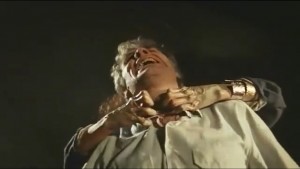


Although at first it may seem that representing the physical destruction of human bodies is a recently created strangeness, the fact is that it is an artistic practice with a long tradition. The French Grand Guignol theater is often cited as the origin of this subgenre, which was practiced at the beginning of the 20th century, where this type of scenes could be seen, representing the physical destruction of human bodies, with great realism, especially if we take into account the precarious development of special effects at that time. But we could go back further in time. In fact, you could say that this art transports us to the beginning of time.
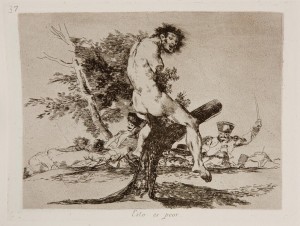 Francisco de Goya “This is worse” (1810-1814)
Francisco de Goya “This is worse” (1810-1814)
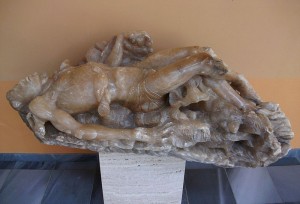 Diego de Tiedra: “San Vicente Martir thrown into the dunghill”, 1533
Diego de Tiedra: “San Vicente Martir thrown into the dunghill”, 1533
In that sense, we bring here an engraving by Francisco de Goya “This is worse” (1810-1814), in which you can see a mutilated body that has been impaled alive; and, likewise, a sculpture that can be seen in the Museum of Fine Arts of Valencia, with a quite expressive title “San Vicente Martir thrown into the dunghill”, by Diego de Tiedra, 1533, in which the saint of the first centuries of Christianity with the body destroyed among the rocks and garbage of the dunghill. In this image, the expression on the saint’s face also stands out, apparently oblivious to what is happening, although, in fact, it is the expression of being in glory, which some art theorists have described as “the joy of pain” [Francisco Calvo Serraller, 2013, p. 139]. It is the representation of a type of ambiguity of a moral order, because what for some would be, in the first instance, something worthy of disgust and rejection, for others, or for them in another context, represents a devotional image that speaks of the sacrifice of the fallen. This, which in appearance may seem very far from the effect pursued by the images of a gore film, the fact is that it has a notable parallel, in that this type of film preserves the same ambiguity in the symbolic, since it moves between desire of wanting to provoke disgust and rejection, often feigned, because the special effects applied do not hide in most cases the falseness of the action that takes place in front of the camera; but at the same time, they are seeking to build a myth, in the figure of the protagonist who accepts the challenge that is placed before him (a challenge that he will neither overcome nor succumb to, because the door must be left open to a possible sequel… ).
It reinforces the idea that these images that show the physical destruction of human bodies are always found in a notable ambiguity, resulting from the fact that they are considerably theatrical and therefore between the reality ―of the theater or of the performance― and the fiction of the representation, no matter how mystical it may be, we see it clearly in a case as notable as that of the film “The Passion of Joan of Arc” (1928), by Carl Theodor Dreyer. A film in which, in case it is necessary to emphasize the idea that we are exposing further, Antonin Artaud, a great playwright, who theorized about the theater of cruelty, in the conviction that theater must affect the audience. Thus, there is a line of continuity in different representation formats, ranging from sculpture, painting, cinema (as an art of image assembly), a line of continuity in which gore cinema is situated, and now Sergio Martín’s film “Haunted Demons”, which rejoices in the barbarism of “Demons”, gutting it and exposing its most gruesome exploits, without us ever being sure if we are suffering or enjoying …waiting for a sequel.
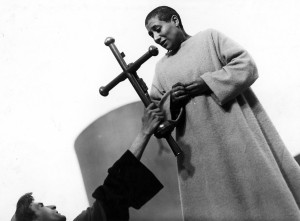
In the image, Brother Jean Massieu (Antonin Artaud) offers the crucifix to John of Arc before being burned alive. In the film there is even a more gory scene, which is when, having fallen ill, John of Arc is bled (a medieval practice) to heal her, and what is seen on the screen is cinema vérité. The effect is so real that it disturbs the most sensitive viewers.
Finally, with regard in particular to “Demons”, and now “Haunted Demons” which is incorporated into the legend, its power of irradiation reaches to this day, without having lost a bit of its power of seduction. We can see it in the latest remembrance of its iconography, which has been produced with the video clip of an iconic musical song by Lana Del Rey (another one): “Chemtrails Over The Country Club”, from 2021. Towards the middle of the video you can see an image that echoes the one created for “Demons”, in which bodies appear, like living dead who walk with their eyes alight (literally) in the dark.
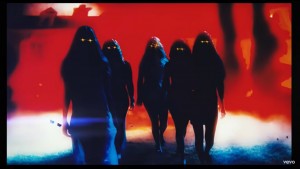
Lana Del Rey: “Chemtrails Over The Country Club” (2021)
Mike Kelley: “A Continuous Screening of Bob Clark’s Film «Porky’s» (1981)”
Reconstruction at La Posta Foundation, within the framework of the film exhibition ˂VHS/VOD/TikTok/Cine˃ Cinema and its Formats, of Mike Kelley’s 2002 installation “A Continuous Screening of Bob Clark’s Film «Porky’s» (1981)” , which, as its name suggests, includes the looped showing of the Bob Clark film “Porky’s” (1981), which is reproduced on a cathode tube television screen, which is the type of screen historically associated with VHS format (and video stores for distribution), all in an environment that suggests a teenager’s room in a student’s residence (in the full title of the installation ―“A Continuous Screening of Bob Clark’s Film “Porky’s” (1981), the Soundtrack of Which Has Been Replaced with Morton Subotnik’s Electronic Composition “The Wild Bull” (1968), and Presented in the Secret Sub-Basement of the Gymnasium Locker Room”―, the presentation of the film ―manipulated in the manner described ―, it would be taking place in the secret sub-basement of the gym locker room, but this seems nothing more than a reference to some of the places where the harassment occurred).
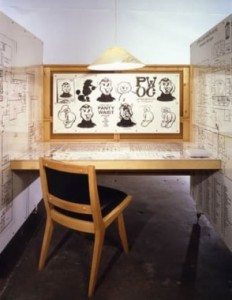
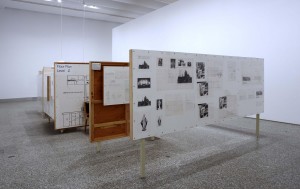
Original appearance of Mike Kelley’s installation “A Continuous Screening of Bob Clark’s Film “Porky’s” (1981)”, as preserved at the MNCARS which acquired it in 2008.
On July 5, 1992, the Los Angeles Times published an interview with Mike Kelley and highlighted in headlines that the artist is an explorer of sexual repression, particularly that which occurs in the earliest stages of life. It is in this context that the incorporation of Bob Clark’s 1981 film “Porky’s” into his 2002 installation “A Continuous Screening of Bob Clark’s Film “Porky’s” (1981)” takes place. Because it is a film that portrays sexual repression during adolescence in the United States. In principle, it refers to the fifties of the last century, a time to which the action of the film takes place, although, nevertheless, the film was made in 1981, and it is already known that a film tells us fundamentally about the moment in which that was done. A moment in which the most important change that had occurred in terms of sexual repression is that the topic is addressed directly without much dissimulation: the entire film is about the obsession of these teenagers with having a sexual encounter. Sexual activity, which, as it could not be with their girlfriends/friends, given the existing repression, necessarily has to occur with sex professionals. In that sense, it is not much different from what here in Spain was called “a Spanishada”, in the sixties or seventies of the last century, when people began to talk explicitly about sex (sex that cannot be practiced by repression), a “film genre” that had a growing development when, during the years of the political Transition, between Dictatorship and Democracy, the cinema of “the uncovering” arrived, another episode of Spanish cinematography, this one of “the uncovering”, which, to despite how singular it may seem to us, it participated in a widespread trend throughout the continent, with productions that were on the limit of pornography, such as “Emmanuelle” (1974), “History of O” (1975), etc.
A film like “Porky’s” has the interest of exploring the sexual repressions that we come from as a society (because one would have to think that it no longer exists today, because sexual relations are approached in a more frank way), and remind us what pathetic that world was. All of them elements that make this film a perfect artifact for a work by Mike Kelly. In fact, in the film there is only one moment of hope, when in scene 15: “The just punishment of Cavanaugh”, at minute 69 (in 2001 the film came out on DVD with a selection of scenes), the abusive father of one of the protagonists receives a few blows at the hands of a police officer (private dress) who interrupts the beating he is giving his son, and the son tells him how humiliating it is that everyone knows that he is his father, and that he is not afraid of him, that don’t get close to him again because he kills you, to which the father answers that for that he would have to be a man, and the son replies that “if being a man means being what you are, I prefer to be «sissy»”.
The reconstruction of “A Continuous Screening of Bob Clark’s Film «Porky’s» (1981)” (2002) by Mike Kelley, seeks to repair an absence. The work was already presented in Valencia, within the framework of the 2003 Biennial, within the exhibition “MicroUtopías” curated by Francisco Jarauta, without the screening of Bob Clark’s film “Porky’s”. The time has come to repair that deficit. And nothing better than in the context of this exhibition of expanded cinema (such as this installation by Mike Kelley, among other qualifications that can be applied to the work), in which the formats of cinema are addressed throughout the last decades, and, in that sense, both the installation and the film are like a collage of different formats. Because “A Continuous Screening of Bob Clark’s Film «Porky’s» (1981)”, includes a version of the film that has been manipulated, by removing the original soundtrack and replacing it with Morton Subotnick’s electronic composition “The Wild Bull” (1968), and what was initially a comedy turns into something paranoid. And as for the context in which the film is watched, that teenager’s room in a student residence that we have referred to before ―and other labyrinthine spaces of repression and harassment in high schools, to which refers to the long title of the installation: “the secret sub-basement of the gym locker room”―; It is an assembly in which, on panels arranged to create a claustrophobic environment, images related to the analytical study of the shape of these cloistered spaces are mixed without order, along with photographs of the extracurricular activities that take place in these centers, which produce between disgust and repugnance, so it hides behind a clumsily innocent image, and/or other people’s shame, because of how poorly his desire to mask has been hidden.

Diagram (one of many) made by Mike Kelley, illustrating the twists and turns in which harassment occurred in high schools and other closed centers, which are at the base of the paneled construction of the installation shown in loop the Bob Clark movie “Porky’s”.
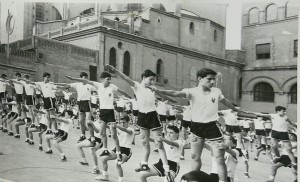
In the reconstruction at La Posta Foundation of Mike Kelley’s installation for the loop exhibition of the Bob Clark film “Porky’s” (with the altered soundtrack), an effort has been made to approximate the reality of Wayne (Michigan) that the artist lived, to the nearest school in Valencia.
Alberto Barinaga: <TikTok/Twitch>
The exhibition ˂VHS/VOD/TikTok/Cine˃ Cinema and its formats is completed, with two works by Alberto Barinaga: TikTok and Twitch, whose names respond to the formats used for their production. In the case of TikTok, it combines images, locating in the upper screen a sequence taken from “France/tour/détour/deux/enfants” (1977), by J.L. Godard, in which a girl is seen talking about her own image; which is combined with the incorporation, below the previous image, of two other images in vertical format like the set, in which you can see the typical TikTok videos with teenagers showing how they apply makeup, and, in doing so, invariably looking for adapt to the same standardized beauty canon.

And as for Twitch, the recognizable interface of this streaming platform is shown, in which you can see the projection of Michael Snow’s film *Corpus Callosum (2001), and in the margins of the window in the film is being viewed, the conversation in the chat that the members of the community who are viewing said film online and live are having.
Both works come to condense an idea that runs through the entire exhibition, which is the indiscernible mixture ―caused by the viewing of all these audiovisuals on the same computer screen or any other device for online viewing―, whether it is works that are part of high culture as if they were products of popular culture, all of this ends up integrating a diverse film discourse, full of interrelationships, enriching an audiovisual experience like we had not known before.
And it is worth highlighting this aspect because it tells us that, rather than finding ourselves facing a moment of end of cinematographic culture, the truth is that we are witnessing the transformation of the artistic experience associated with the viewing of audiovisual images, in a way that, surely, has not occurred since the beginning of cinema. In this sense, it is worth paying attention to the fact that Twitch, for example, with the simultaneous streaming by many users of the same movie, creating a community to which they have been specifically summoned, and participating in a chat in where ideas about the film being viewed are expressed and debated, comes to actualize one of the defining factors of cinema, such as its ability to generate the public sphere (in addition to the self-awareness factor of being cinema, to which Aitor de Maenza at the presentation of this film exhibition). Consequently, nothing could be further from a supposed death of cinema, which has been talked about for so long that, one could say, in the wake of “Porky’s” or “Demons”: that this dead man already smells.

˂VHS/VOD/TikTok/Cinema˃ Cinema and its formats
A history of cinephilia from VHS to Twitch. Culturplaza Podcast


